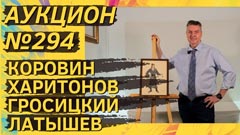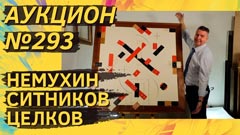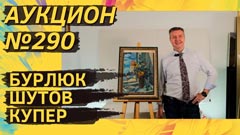
MASTERPIECES
SVESHNIKOV Boris Petrovich (1927–1998) Walk. 1998. Oil on canvas. 75 × 50
Works by the 1960s artist Boris Sveshnikov regularly participate in our auctions, but still recall the biography. At the age of 19, he was sent to a prison camp due to slander, for anti-Soviet activities. The “goner” dying of exhaustion was saved by the paramedic Arkady Akimovich Steinberg — the artist of the “Silver Age” and the father of Eduard Steinberg. Perhaps it was precisely that camp horror that gave rise to that very unique imagery in Sveshnikov's work — with monsters, graves, infernal figures. What is called “Kafkaesque romance”.
Why is this particular job interesting? This is the largest, and perhaps the best of those that took place in our auction. It has the highest degree of elaboration — subtle divisionism and a good plot. An absolutely collectible item.
VULOKH Igor Alexandrovich (1938–2012) Still life. 1987. Oil on hardboard. 70 × 90
Aesthetic nonconformist. After the dispersal of the exhibition in Tarusa in 1961 and the subsequent expulsion from the institute for sudden incompetence, Vulokh did not participate in high-profile projects with political overtones. He was a loner, not a member of a group.
The work presented at the auction is large and simply of exceptional quality. In 2006, at Sotheby's, a still life of a similar class was sold for almost $ 20,000. In general, his auction record was under $ 30,000. Now, to the delight of new collectors and investors, prices are much lower. We think this is not forever — take this opportunity.
1960s NONCONFORMIST ARTISTS
YURLOV Valery Ivanovich (1932) Composition with a red figure on a blue background. 1968. Oil on canvas. 80 × 50
Valery Yurlov is one of the first and main abstractionists in post-war Russian unofficial art. His language dates back to the 1950s, despite many circumstances. Yurlov was lucky to study at the liberal Polygraphic Institute, where teachers who were noticed to be disloyal to the socialist realism system were “exiled”. It was so. Some teachers, even during Stalin's time, secretly told their students about the avant-garde art of the beginning of the century — Matisse, Chagall, Malevich. At the Polygraph in the early 1950s, a group of talented students was singled out by the teacher Pavel Zakharov, who secretly taught them according to the VKHUTEMAS system with the technique of “revolution of consciousness”. Zakharov took students to boxing so that the students learned to notice and paint nature in motion. But it turned out that Yurlov went further in the experiments, abandoned the figurative, which disappointed even an advanced teacher. A few years later, the idea of a “counter-form” or “pair of forms” appeared in his work. To simplify greatly, this idea is based on two states of the object — before and after exposure. The artist owes its appearance (as in the case of the Nemukhin cards) to chance — to a random impression. One summer he lived in a house on the seashore in Abkhazia, sat on the shore and watched the objects that were thrown out by the sea. “And I found a tin can being broken by a wave. The wave transforms it into a completely different form — here is the same can, but completely new. And since I was engaged in still lifes, comparisons, I simply put such objects on the table, drew and somehow found this "was-became" influence”.
Needless to say, Yurlov was not exhibited in the USSR. Like many independent artists, he earned his living as a book graphic artist and worked for Detgiz publishing house. With varying degrees of success. For example, for the “formalist” illustrations to Lorca he was not given a job for four years. Today, Yurlov's exhibitions are held in the best museums in the country, and he is also known in the United States.
GROSITSKY Andrey Borisovich (1934–2017) Curtains. 1999. Oil on canvas, mixed media. 90 × 75
Metaphysics of the objective world. Poetry of things. We know Grositsky from the aesthetics of rusty pieces of iron, meat grinders, and irons. It would be better with red color as well. And here we have Grositsky, “Curtains”. Maroon curtains on a red background. A large spectacular thing. Museum quality. A find for the collection.
NEMUKHIN Vladimir Nikolaevich (1925–2016) Jack Kandinsky. 2010. Paper, gouache, pastel, collage. 49.5 × 40
In the line of Vladimir Nemukhin's jacks, our customers have already met Chagall, Mayakovsky, and Meyerhold. And here is another dedication to one of the main innovators of the twentieth century — Wassily Kandinsky. Successful lawyer Kandinsky gave up his former life and became an artist at the age of 30 — under the impression of impressionism, from Claude Monet's Haystacks. And he himself turned a page in the history of art and went further, becoming the father of abstract art.
It’s even a pity to sell Nemukhin’s work — it is of great use to us in the office. Just recently, we conducted a tour for the young generation. Explained to the children in chronology — about the Russian avant-garde, about socialist realism, about the emergence of the 1960s artists — “the second Russian avant-garde”. As you can imagine, we have a lot to show about the second Russian avant-garde — in all its glory. From Rabin to Bulatov. We also found something on socialist realism, albeit not much. Well, as for Kandinsky and Malevich, alas, there is nothing to illustrate with. So we had to call for help from Steinberg with the supremes, and Nemukhin with the first symbols of Kandinsky. We managed somehow. The work is wonderful, it will surely be bought and we will have to do without illustrative material.
1970s ARTISTS
KAZARIN Viktor Semenovich (1948) Red, black, gray. 2012. Oil on canvas. 90 × 90
Another unexpected Kazarin. The seventies artist, participant of exhibitions in the City Committee on Malaya Gruzinskaya, a well-known abstract expressionist performs here in a different role — as the author of a non-objective, post-suprematist series. Figures, lines, volumes and backgrounds shimmering over the edge of the canvas — yes, this is the Kazarin series of the early 2010s. Around that time, he prepared and held a large exhibition of abstract canvases at the Central House of Artists.
FEOKTISTOV Vladimir Petrovich (1947) Village promenade. 2004. Watercolor on paper, author's technique. 58 × 44.5 (in light)
We love to remember and associate artists with other eminent colleagues and foreign masters. Such comparisons are fraught with inaccuracies and gross errors. But they are easy to remember. Let's remember about “Weisberg — Russian Morandi”, “Purygin — Russian Bosch” or “Rabin — Solzhenitsyn of painting”. So Vladimir Feoktistov is called the Bruegel of the Russian province. Meaning the Flemish Pieter Bruegel the Elder — “Peasant Bruegel”, who in his work loved to turn to the peasant life of the people. However, here you can see the influence of both Bosch and Filonov — the author's favorite artists.
Vladimir Petrovich Feoktistov is an artist of the orbit of unofficial Russian art, although not from the main “clip”. His personal exhibition took place only in the early 1980s, with the support of academician Petr Kapitsa. What is Feoktistov appreciated for? An absolutely recognizable style — naive expressionism, absolutely Russian in spirit. Vivid characters, complex subjects — everything that is important to connoisseurs of painting.
RUSSIAN ABROAD
BURLIUK David Davidovich (1882–1967) French Morocco. 1954. Pencil, ink, pen, watercolor on paper. 38.2 × 29.4
Last time the viewers made a comment to us that when talking about one of the works, we did not show the expertise on the video. We are correcting. Moreover, in the case of Burliuk, it is necessary.
The expert opinion of Valery Silaev describes the history of the appearance of this drawing. Indeed: where is the father of Russian futurism and where is Morocco? And the fact is that in 1954 the Burliuk family went on a cruise, and then to Africa. In French Morocco, Burliuk admired archaic aesthetics, ethnic types, views and natural landscapes. By the way, the dot on the forehead and the line on the chin are not an artist's fantasy, but typical tattoos of Berber women. Perhaps, at the sight of these signs, Burliuk remembered how, in the days of his tempestuous youth, he and Mayakovsky also walked around with painted faces and a spoon in the buttonhole of their jacket, giving slaps to the public taste. By the way, it was thanks to Burliuk's persuasiveness and his financial support that Mayakovsky, who was shy about his poetry, began to write.
LYUBICH Osip Markovich (1896–1990) Walk. 1920–1930s. Canvas, oil. 46 × 38
Lyubich is an artist of the Russian diaspora, a painter of Belarusian origin. The name is not well known. This is the first time we have his work at auction. So a few words about the artist. Yes, this is the Paris School, to which Modigliani, Marevna, Rivera, Soutine and others belonged. Before Paris there was Berlin. Lyubich came there from Odessa, made friends with Ivan Puni and Pavel Chelishchev, worked as a theater artist. Then Paris. He went there by invitation to arrange a cabaret in Montmartre. But it turned out that for life. There he worked for many years, participated in the Parisian salons. From Paris, he, a Jew, was taken on a denunciation to a fascist concentration camp, which he miraculously survived, because he was arrested shortly before the liberation of France. He returned to the Paris workshop and lived a long life. The artist died in 1990 and is buried in the Montparnasse cemetery.
PAY ATTENTION
BAZILEV Sergey Nikolaevich (1952) Land!!! 2012. Oil on canvas. 65 × 100
Sergey Geta, Sergey Bazilev and Sergey Sherstyuk are well-known representatives of Soviet “hyperrealism” or “documentary romanticism”. When they were young, they were called “the Kiev railway station group” — for the fact that they constantly traveled between Moscow and Kiev. They became famous in the early 1980s. All-Union and republican exhibitions, catalogs, fees, trips abroad — they were in great demand. Then the collapse of the Soviet Union. The processes went such that the country had no time for “hypers”. And then another art came into fashion — highly social, grotesque, violent. The return of interest in documentary romanticism is a process unfolding right before our eyes. Geta and Bazilev regularly put up for auction. Today's Bazilev is the moment when they shout from the boat “Land!!!” — a long-awaited moment after many days at sea. Blue wave, the foam of the surf, the mood plus a recognizable hyperrealistic manner.
VOLIGAMSI Rinat (1968) Conversation. 2000. Oil on canvas. 40 × 80
This is Voligamsi of 2000 — at the moment when he just started his super successful career ascent. But this work already has everything that is expected of a Bashkir artist: a mysterious plot, mythical characters, a mysterious atmosphere and a recognizable style of retro-realism. Voligamsi is a well-known contemporary artist, nominee for the Kandinsky Prize.
- Log in to post comments










